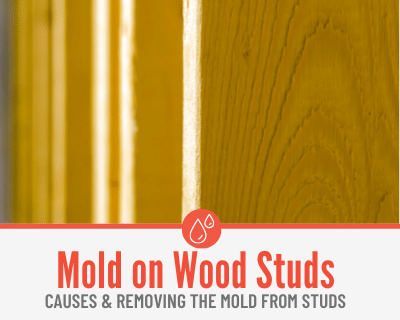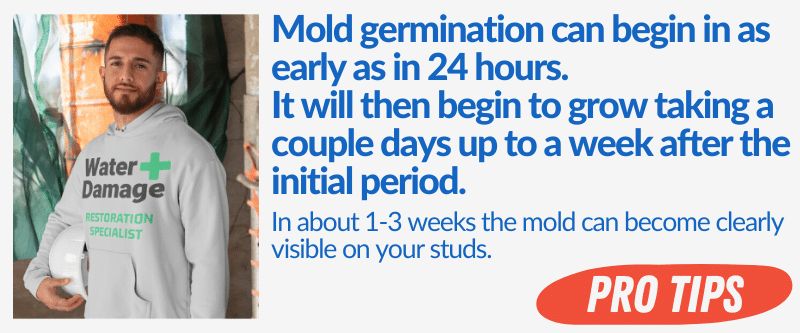Worried there Might be mold on your wall studs behind drywall?
In this guide you will learn:
- How to Tell if there’s mold on Wood studs,
- Common Causes of Mold on Wood Studs & How Dangerous it might be,
- How to Remove Mold from your Wood Studs,
- Prevention Techniques to prevent Mold from growing on your wall studs in the future.

Signs of Molds on Wood Studs Behind Drywall
One of the first ways to tell if you have mold on your wood studs is by the smell.
Before you might be able to see any visual you might be able to smell something musty or earthy. These are telling signs of mold build up.
Additionally, specific visuals are a good indicator that mold is growing on your wood studs or walls. Below is a list of the most common visuals that indicate this growth:
- Stains and spots on the wall.
- A growth that looks like dirt.
- Rings and water stains (especially if accompanied by moisture in that area).
- Discolorations.
- Any cracking or peeling paint on the walls.
You can do a quick mold test by dabbing bleach on the suspected spot. (Make sure you dilute the bleach with 16 parts water).
You can ask yourself, does the spot go away or keep coming back. If it keeps coming back, then you can be sure that it is something organic and growing like mold.
In addition to the quick method mentioned above, mold testing kits are available at the stores. These kits allow you to test the surface or test the air. Using a professional kit will be more time-consuming and likely cost you more money.
Here are a few different highly recommended mold testing kits available online or in stores:
- Healthful home five-minute mold test
- DIY mold testing
- Mold armor FG500
It is important to note that one leak can lead to mold growth. You do not have to have a flooding or another major water event.
Any area of your home with excess moisture and/or poorly ventilation are areas for potential mold growth.
Suspecting Mold on your Studs?
Call 844-488-0570 for a Risk Free estimate from a Licensed Mold Remediation Specialist in your area.
We Can Help Remove Mold from Wood Studs and your whole house.
Common Causes of Mold on Wood Studs
Mold behind the drywall is one of the most common areas for mold growth in the home. Wood, drywall, and cotton are ideal sources of food for the growth of mold.
Below are some of the more common causes and areas for mold growth in the home that can lead to mold forming on your Wood Studs.
Humidity
Excessive moisture in the air is an ideal condition for mold growth. The summer months may be worse.
Consider these areas in your home and how you can provide for better ventilation. Very high interior humidity can be a source for extensive mold growth on your studs.
Water sources
Often leaky pipes and or a leaky roof cause problems for mold growth on wood studs. Cracks in your foundations and water coming up from the floor are another source especially in your basement area.
If you have an attic, do not forget to check that space for mold growth if you have issues with a leaky roof.
Roof and foundation leaks are a common cause of mold.
Basements
This is a natural place for the growth of mold, especially on wood materials such as studs. Basements typically have poor ventilation (they are underground) and they are excessively moist. Basements are also a common place for leaks in the home and a place where water can accumulate in small hidden areas.
During construction of a home
Check the site for issues before and during construction. Common basement issues like water build up or general ventilation issues will cause mold build up at the construction site and on your wall studs.
The Wood used for stud work from the suppliers may already have come with mold growth on it. Additionally, worker negligence about the issues can happen. Builders may ignore the mold problem on your wood studs and just keep building.
Bathrooms
Since mold loves dark, damp, moist places bathrooms are an ideal place for the growth. Bathrooms often will lack ventilation and allow for mold build up on studs. Damp materials in the bathroom like rugs, carpets, wood, and paper will allow for mold build up. Mold feeds off materials like these.
Leaving wet clothes lying around the house after a workout is a common source of buildup. In a poorly ventilated area like a bathroom this can be a cause of mold.
Other common causes / places for mold build up.
Severe flooding and moisture build up from an overflowing dishwasher in the kitchen.
A leaking air conditioner and small pools of water gone unnoticed over time.
During wintertime, your home having a buildup or condensation.
How Dangerous are Mold On wood Studs?
Mold on the studs and in your house poses a risk both health wise and it can also cause serious damage to your house. Children, and people with weaker immune systems are more susceptible health wise.
Health issues
Mold can cause a host of non-specific health issues like coughing, watery eyes, wheezing, runny nose, fever, headaches, and difficulty breathing.
Those with asthma and respiratory issues can be the ones most effected.
Additional symptoms maybe pain in the joints, nasal congestion, skin irritation and pneumonia. Also, mold can create health issues for your pets.
Structural damage
Mold can cause serious structural damage to your home. Mold will eat way at wallpaper, tiles, drywall and on the wood studs.It will cause long term damage and the mold can destroy you home.
How mold works is that the particles on the dry wall provide a food source for mold and its continued growth. Left uncheck, over time, this will be the source of major structure issues.

Black mold on studs Vs. White mold on studs
There are two different kinds of mold build-up that you should be on alert for wood studs. Both types of molds will grow due to excess moisture build up and in areas with poor ventilation.
As you can see below black mold has a higher profile (and is more dangerous) than its cousin white mold (mildew).
Both kinds of mold can be extremely damaging to your health and home. Always address the situation immediately and use tips from this article to test and correct any mold growth in your home.
| Black mold (Stachybotrys) | White mold (Mildew) |
| Black mold will become fuzzy on your studs | White mold will normally stay flat on studs |
| More harmful to health than white mold | Will convert to a powdery substance |
| Dark green in color that changes to black | White and grey in color can turn brown |
| Higher profile than white mold | Lower profile than black mold |
| Oftentimes can look like dirt on your wood studs. |
Hot to Treat and Remove Mold on Wood Studs
Before you begin the do-it-yourself removal ,be sure to inspect the area thoroughly. Mold can grow in tiny, dark spaces so surveying the area and assessing the total problem is important.
You should consider consulting a professional if the growth on your wood studs and area is too large for you to handle.
The goal of mold removal from the wood studs is to remove all the spores and fungus from under the surface but that might not necessarily mean removing all the stains from the wood.
If the studs are unfinished, it may be appropriate to do a light sanding as to allow for better, deeper access of the cleaning agents under the surface.
Using bleach to remove mold from wood studs.
Bleach is the common choice for halting mold growth but not necessarily the best. Bleach is effective to remove small amounts of mold on the surface, but it will not penetrate the wood studs and kill mold spores deep under the surface.
Bleach may cause mold growth to retreat further under the surface, but bleach will not penetrate the surface. Bleach must be diluted if using as a mold removal agent (recommend 3 parts water to 1 part bleach).
You need to kill mold growth under the surface and prevent it from future growth.
Using vinegar to remove mold from wood studs.
For small amounts of mold on wood studs, vinegar and its acid will effectively penetrate the surface and kill mold and its spores preventing future growth.
White distilled vinegar is effective for killing mold.
Do not dilute the vinegar and use the white distilled to spray on the surface at full strength. The vinegar will need time to soak in and saturate the wood. This allows for it to attack mold spores under the surface.
Tools you need to complete this task:
Gloves, mask, scrubber, detergent in a spray bottle, Lysol wipes, hand sanitizer, fan, and a HEPA vacuum.
Remember, before you start the do-it-yourself mold removal to always think safety first.
Steps:
- Open windows, if possible, to allow for maximum ventilation to the wood.
- Start by vacuuming with the HEPA filter to remove tiny particles of mold from the wood studs.
- Apply the vinegar in spray bottle to the wood studs but make sure you do not over saturate the wood.
- Allow for the vinegar to soak into the studs 45 minutes to an hour.
- Use the stainless-steel scrub sponge to scrub the wood clean.
- Use paper towels to dry the studs and clean off the remaining detergent.
- Apply the Lysol wipes to the wood studs to disinfect the wood.
- Use the paper towels again to dry the wood off.
- Use the HEPA vacuum again. The HEPA vacuum can trap extremely tiny particles of mold and stop mold particles from dispersing into the air.
- You can repeat steps as necessary and needed.
If the mold is still present on your wood studs it is likely that there is a heavy growth underneath the surface. As mentioned above, a light sandpapering of the unfinished wood will allow you to attack the spores under the surface.

How to Prevent Mold on Studs in Future?
By taking a few simple steps you can prevent mold from growing on your wood studs. Always be alert and vigilant to the conditions of your home and of the different “hot spots” for mold growth in the home.
These hot spots are areas like your basements, bathrooms, and other areas where moisture build up can occur.
Steps to prevent mold on studs in the future:
- Be alert and monitor moisture areas. Keep these areas of your home clean.
- Fix any and all leaks in the home immediately.
- Increase the ventilation in problem areas by using fans.
- Use de humidifiers. De humidifiers decrease humidity by and up to 50%.
- When applicable use natural sources of ventilation like windows for air flow.
- Increase sun light to reduce moisture.
- Service your mechanical venting and make sure it works properly. Fix any clogs or backups.
When to call a Professional?
Here are some quick tips as to when it maybe necessary for you to call a professional to handle your mold growth problem.
A professional will use chemical agents (stronger than home mixtures and over-the-counter substances) to remove the mold from the studs.
- If the mold growth is too big or over 10 square feet of surface space.
- If you can smell the mold but you cannot find the source.
- If you have highly susceptible people living in your home (respiratory issues, allergies, asthmas, weak immune systems, major surgery/organ transplants, or young children).
- If the mold is inside of your walls and you cannot get to it without a demo of the room.
- If you suspect the mold is causing structural issues and an engineer needs to evaluate.
Make sure you do your homework and get multiple quotes. Also, if possible, check for references, certifications, experience, and licenses when comparing companies.
We have Mold Remediation Technicians that can help Remove Mold from your Wood studs, Prevent it from Returning & Restore Any Damage Done by Mold.
For Disasters of all Sizes,available in 95% of USA
